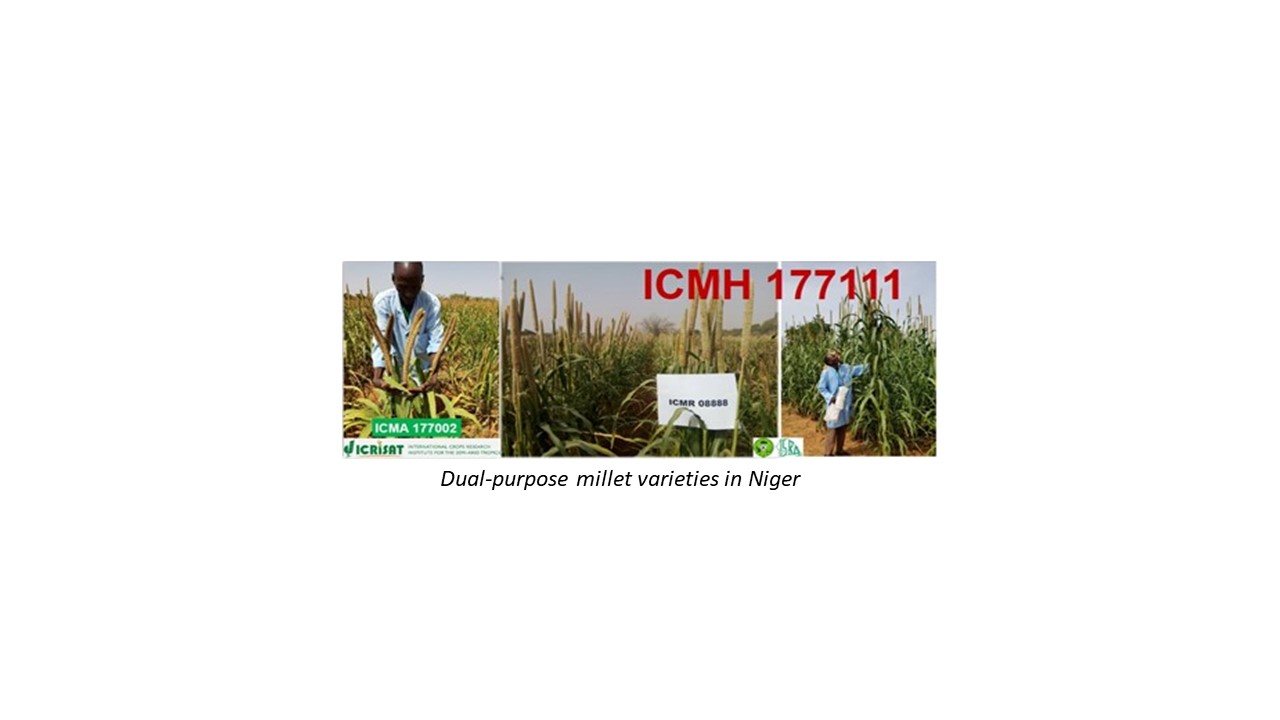Dual-purpose Varieties for Crop and Livestock Integration
Summary
Diminishing productivity of natural pastures and rangelands across African drylands due to overgrazing, soil degradation and climate change, coupled with increasing livestock numbers, increases the importance of crop residues used as animal feeds. Traditional varieties of millet and sorghum are unable to satisfy demands for food and feed at the same time as they do not have a favorable ratio of grain to stover. Commonly cultivated lines also have a higher lignin content, reducing their digestibility, while some also contain sufficient tannin to lend a bitter taste. New higher yielding, “dual-purpose” millet and sorghum varieties with ideal grain and stover ratios for both human and animal nutrition are now available. These improved cultivars contain less lignin and tannin, and stay green through grain harvest, allowing farmers to obtain greater fodder quantity and quality into the dry season. The new lines of millet and sorghum allow more intensive crop-livestock integration as improvements in fodder availability enhance manure availability for use in soil fertility management.
About the Solution
Varieties for dual-purpose produce about 40% of grain and 60% of stover on dry matter basis. Sorghum lines achieve grain yields of 2.5 - 4.0 ton ha-1 and stover yield of 10 - 15 ton ha-1. For millet cultivars, the productivity ranges between 2.0 and 2.5 ton ha-1 for grain, and 4.0 - 6.0 ton ha-1 for stover. The new cultivars possess traits that help them survive dry-spell and quickly resume growth when moisture returns. In addition, sorghum lines tolerate both drought and cold better than other fodder crops such as maize and Napier grass. The stover of the dual-purpose sorghum cultivars is sweet with a sugar concentration around 15%, matching the energetic value of maize, and its juice can be extracted for syrup or bioethanol production as well. While traditional millet varieties achieve higher production of fodder on dry matter basis, the new dual-purpose lines provide greater digestible stover yield and metabolizable energy per area of land. Improvements of harvestable grain and stover, nutritional quality and stress resistance in millet and sorghum offer greater food and feed security to farmers.
Dual-purpose varieties available to seed producers are suitable for a wide range of African agroecosystems through selective adaptation for specific growing conditions, including Sahelian and Miombo drylands and sub-humid regions.
ICRISAT and partners from the Institut d’Economie Rurale in Mali developed and registered more than 15 OPV and hybrid lines of dual-purpose sorghum, including cvs. Soubatimi, Tiandougou Coura, Jiguikala, Seguifa, Peke, Fadda, Sewa, Nieleni, Grinkan Yerewolo, Sassilon and Sariasso 22. A series of OPV and hybrid cultivars of dual-purpose millet are available, including MISARI 1 and 2, NAFAGNON, ICMV, ICMH, Mil de Siaka, SOSAT-C88, Toroniou C, Synthetique 00-06/03-03 and Thialack 2.
The dual-purpose varieties are developed using conventional techniques of crossing and hybridization and subjected to rigorous field tests before their release. Land preparation, seed rate, plant spacing, fertilizer application, and crop management should follow generally prescribed practices for growing areas and seasons. It is important to note that sorghum stover is wilted for at least 12 hours before feeding to animals so that hydrogen cyanides are broken down, else these they may cause poisoning. Green or dry stover must be chopped into pieces of 2 cm when used as fodder for cows, pigs, and goats, and must be shredded into pieces of less than 0.5 cm for poultry. Millet and sorghum stover can be used for silage in pits or under plastic during which fermentation releases extra sugar and breaks down anti-nutrients. Because of the high sugar content in sorghum, no molasses must be added to silage. Fodder from sorghum, either as green chop or silage, can replace maize at equal amounts for all types of livestock, and provides up to 67% of required roughage and up to 20% of the total diet.
Commercialization
Commercially available
Solution Images
Institutions


